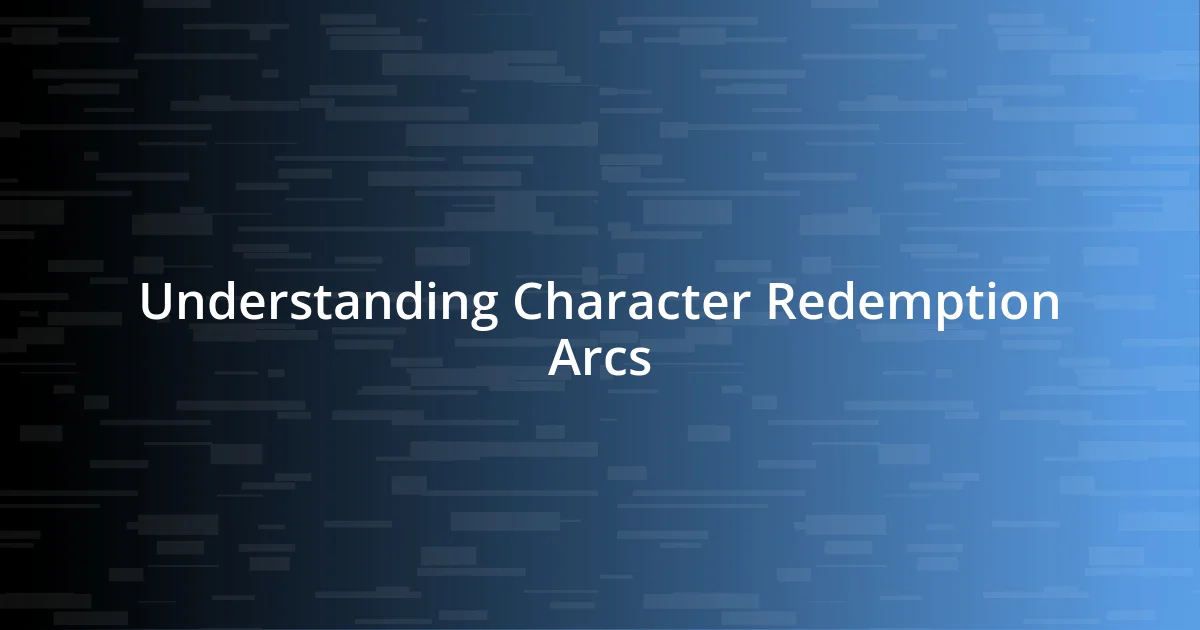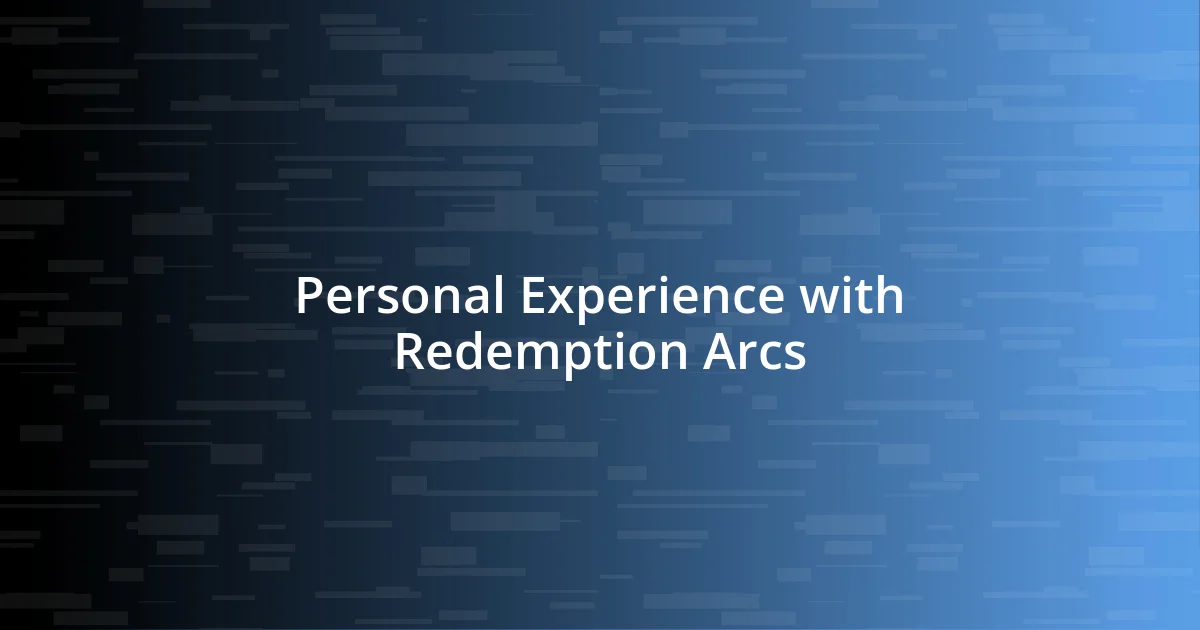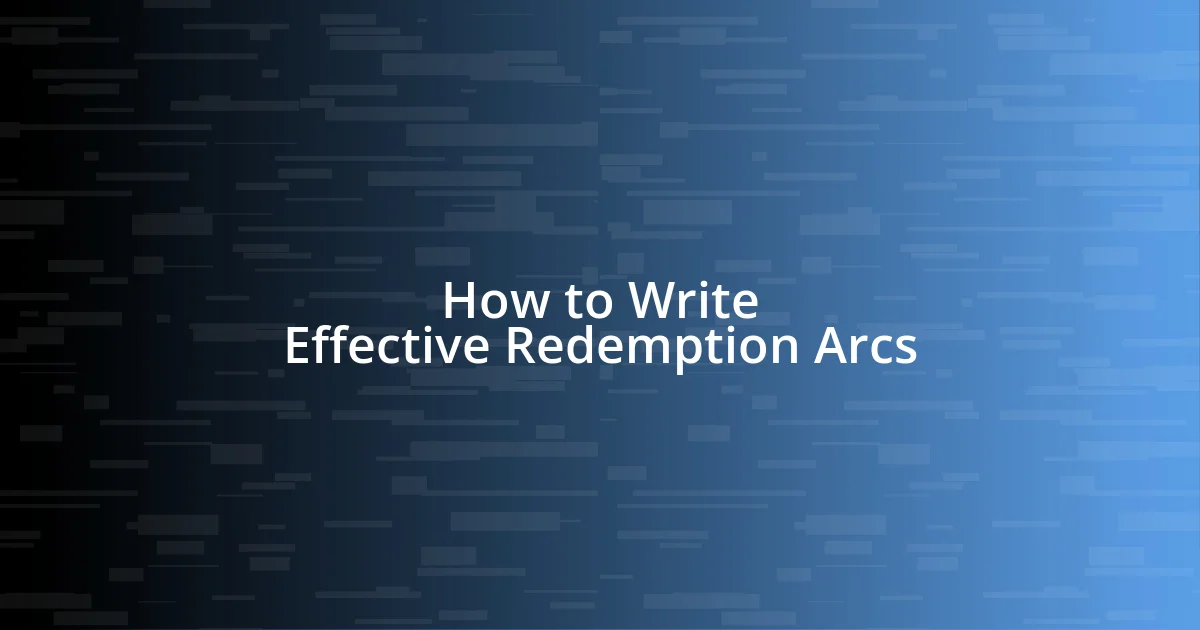Key takeaways:
- Character redemption arcs are driven by self-awareness, catalysts for change, and the understanding of consequences, reflecting personal growth and human complexity.
- Redemption requires consistent effort, vulnerability, and often involves relationships that guide characters toward reconciliation and healing.
- Memorable redemption examples, such as Severus Snape and Walter White, illustrate how profound choices shape identities and highlight the importance of acknowledging one’s past actions.

Understanding Character Redemption Arcs
Character redemption arcs are fascinating because they allow characters to evolve through their flaws, mistakes, and ultimately, their transformative choices. I remember watching a series where a seemingly irredeemable villain began to question his actions after forming a bond with a child. It made me wonder—what makes someone seek redemption? Is it guilt, the desire for connection, or something deeper?
These arcs resonate with us because they mirror our own struggles with growth and change. I’ve often found myself relating to characters who falter and then make a conscious effort to improve. It’s a reminder that even the most flawed individuals can strive for betterment and that it’s our choices that define us, not our past mistakes.
Redemption isn’t always about grand gestures; sometimes, it’s the small, quiet moments that matter most. I’ve seen characters take baby steps toward redemption by simply apologizing or making sacrifices. Have you ever considered how a simple act of kindness can change a person’s trajectory? It’s those moments that offer a glimpse into the complexity of human nature and the possibility of change.

Key Elements of Redemption Journeys
A successful redemption journey often hinges on a few key elements that weave together the narrative. One crucial aspect is the character’s self-awareness, where they begin to recognize their flaws and the pain they’ve caused. I recall a character who hit rock bottom, sitting alone in a dimly lit room, reflecting on their past deeds. That moment of clarity is often a sparkle of hope amid despair, and it sets the stage for their journey forward.
Here are several essential components that contribute to strong redemption arcs:
- Catalyst for Change: An event or relationship that sparks the character’s desire for redemption.
- Inner Conflict: Struggles with guilt, shame, and the desire for forgiveness create depth.
- Support System: Friends or mentors who guide and challenge the character on their path.
- Acts of Redemption: Meaningful actions that demonstrate growth, even if small.
- Consequences of Past Actions: Realizing the impact of their past choices adds weight to the journey.
- Moments of Relapse: Experiencing setbacks reminds readers that change isn’t linear and makes the eventual success more rewarding.
Understanding these elements helps to appreciate not just the story itself, but also the emotional resonance behind it. As someone who has often rooted for characters on their hard-fought journeys, I find connection in every stumble and triumph they experience. It’s as if their struggles mirror my own in unexpected ways.

Personal Experience with Redemption Arcs
I’ve encountered many characters whose redemption arcs have deeply influenced my perception of personal growth. For instance, I remember watching a film where a once-selfish protagonist saved someone from danger. The fear in their eyes while making that choice was palpable, and it reminded me of moments in my life when I had to make tough decisions. Those instances often turn out to be the most defining in our journeys, don’t they?
Reflecting on my own experience, I can relate to the struggle of overcoming past mistakes. There was a time when I had to confront the aftermath of an unkind action I took toward a friend. A simple apology wasn’t sufficient; I found myself working hard to show through my actions that I’d changed. That personal confrontation echoes the arcs I’ve seen in various stories — how important it is not just to feel sorry, but to actively strive for improvement.
In narratives, characters often experience setbacks during their redemption. I used to be frustrated when my favorite characters relapsed, but now I see those moments as authentic. Just like in real life, I might take one step forward but find myself backtracking at times. Embracing the ups and downs has made me appreciate the journey even more. What have those moments taught you about your own redemption path?
| Character | Redemption Experience |
|---|---|
| Protagonist in a Movie | Saved someone, realizing the weight of their past actions through fear and growth. |
| Friendship Struggle | Apologized and worked hard to show genuine change; small acts mattered most. |
| Relapsing Character | Setbacks reflecting real-life growth; understanding the journey is never linear. |

Impact of Redemption on Characters
Redemption has a profound impact on characters, shaping them in ways that resonate with readers. I remember a novel where a former villain chose to protect their once-enemy out of empathy. This decision not only transformed their image but also revealed layers of complexity we didn’t initially see. It quite literally changed the course of their life, showcasing how one act of courage can redefine identity.
Characters who undergo redemption often experience an emotional rebirth. I can’t help but think of a story where a character had to confront their manipulative past and, in doing so, discovered a sense of belonging. The vulnerability during those moments is palpable; it’s as if they’re peeling away layers of armor to expose their true selves. Have you felt that intense connection when a character sheds their past? I know I have—I feel an overwhelming sense of hope for their journey, as if they’re showing me that change is possible.
When redemption is achieved, characters often find new purpose. Take for instance a character who starts mentoring others after overcoming their flaws. I found myself reflecting on my own experiences in community service, where I learned that helping others not only benefitted them but strengthened my own resolve. It’s fascinating how storytelling mirrors reality, isn’t it? Watching a character step into their new role feels like an invitation for all of us to look at our own paths and consider how we too can rise from our mistakes.

Lessons Learned from Redemption Stories
Redemption stories often teach us about the power of vulnerability. I recall a moment when I finally opened up about my failures to a close friend. It was scary, but once I shared my struggles, I felt a weight lift off my shoulders. That experience mirrors what I’ve seen in redemption arcs—characters bravely confronting their flaws often find strength in their honesty. Have you ever let your guard down like that? It can be incredibly liberating.
One of the most poignant lessons I’ve learned is that redemption requires consistent effort. There was a phase in my life when I wanted to change my unhealthy habits, but it wasn’t a straightforward path. Repeatedly, I stumbled before making real progress. In narratives, characters who fall back into old patterns remind me that true transformation doesn’t happen overnight. It’s a process filled with trial and error, just like my own experiences. How often do we forgive ourselves for our setbacks, though?
Finally, I’ve come to appreciate that redemption stories often highlight the significance of relationships. I think of a character who, after realizing their wrongs, sought to rebuild trust with those they hurt. I’ve had a similar experience when trying to mend a friendship I nearly lost; it took time, patience, and many heart-to-heart conversations. Those connections often serve as a mirror reflecting our growth. Isn’t it fascinating how the bonds we forge can guide our journey toward redemption?

How to Write Effective Redemption Arcs
Crafting effective redemption arcs hinges on a deep understanding of character motivations. I remember a story where the hero’s turning point stemmed from a moment of profound loss. It made me realize how pivotal such experiences can be—what if their moment of clarity was sparked by something we all fear losing? That’s the kind of emotional depth I strive to capture in my writing, as it helps readers forge a connection with the character.
Another key element is gradual change. In one of my favorite novels, a seemingly irredeemable character slowly reveals their vulnerabilities, teasing out redemption in a way that feels authentic. Have you ever watched someone you know transform through small, deliberate actions? It’s in those tiny steps that we truly see growth. The slow build-up can heighten the stakes, making the eventual redemption feel not just earned but inevitable.
Lastly, I find it essential to show the consequences of a character’s past actions. Reflecting on my own life, I’ve learned that ignoring our mistakes doesn’t make them disappear; it often complicates relationships further. In one gripping tale, a character’s attempt to make amends leads to unexpected challenges, echoing my own experiences of apologizing to a friend after a misunderstanding. That struggle to rebuild trust is universal, isn’t it? It’s this layered complexity that brings realism to redemption arcs, inviting readers to explore their own journeys alongside the characters.

Analyzing Successful Examples of Redemption
One of the most memorable redemption arcs I’ve encountered is in the character of Severus Snape from the Harry Potter series. Initially portrayed as a bitter figure, his eventual motivations reveal layers of sacrifice and love, showcasing how darkness can stem from deep-seated pain. Reflecting on this, I think about people I’ve met whose harsh exteriors hid remarkably tender hearts. Have you ever unraveled someone’s story to discover the vulnerability beneath their defenses?
Another striking example is Walter White from Breaking Bad. His transformation from a mild-mannered teacher to a ruthless drug lord is compelling because it encapsulates the consequences of his choices. I remember when I faced a similar crossroads, driven by ambition but later realizing the impact of those choices on my relationships. Isn’t it profound how the quest for redemption often starts with acknowledging the chaos we’ve created in our own lives?
In literature, characters like Jaime Lannister from Game of Thrones illustrate redemption through unexpected moments of empathy, often leading to significant character shifts. I once had a colleague who surprised me by publicly acknowledging their mistakes in a difficult team meeting. That moment of honesty not only shifted their standing but also encouraged others, including myself, to reflect on our vulnerabilities. How powerful can it be when someone takes that courageous step to right their wrongs? It reminds us that redemption isn’t just a solo journey—it’s often intertwined with the growth of those around us.














